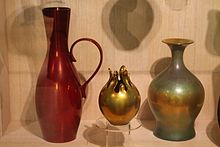Eva Zeisel
Eva Zeisel (* 13. November 1906 in Budapest , † the thirtieth December 2011 in New York ), also known as Eva Stricker Zeisel was an American industrial designer , mainly by their ceramic works from the period after their immigration to the United States known has been. Works from Zeisel's career can be seen in museum collections around the world.
Life
Zeisel was born as Eva Amalia Stricker into a wealthy and educated Jewish family. From 1923 to 1924 she studied painting at the Royal Art Academy in Budapest . She then got an apprenticeship as a potter , opened a workshop at the Kispest ceramics factory in Budapest and developed prototypes. From 1927 she designed for Hansa Kunstkeramik in Hamburg and from 1928 to 1930 she was a designer for the Schramberg Majolika in Schramberg . There she designed numerous tea sets, vases, inkwells and other ceramics. Her designs for the Schramberg majolica were largely based on nature and were influenced by the Bauhaus style, from which she later distanced herself, however, by calling it "too cold" to the New York Times. In 1930 Eva Stricker moved to Berlin, where she worked as a designer for Christian Carstens.
In 1932 Eva Stricker went to the USSR , where she worked as one of the foreign experts who were very welcome there at the time. She designed ceramics for the state porcelain factories Lomonosow and Dulewo. In 1935 Zeisel even became artistic director of the Soviet ceramic industry. This success was short-lived, however, as she was arrested on suspicion of being a co-conspirator in an assassination attempt on Stalin . After almost a year and a half, she was released and expelled to Austria . After her release she returned to Budapest and had to flee again, this time from the National Socialists . She came to England via Switzerland.
In 1938 Eva Stricker left the country with her future husband Hans Zeisel . The wedding took place in England , from where she emigrated to the United States that same year, where she lived in New York and had two children with Hans Zeisel. She continued to design practical, modern tableware, including the Museum White (1942–45) collection, which she developed in cooperation with the Museum of Modern Art (MoMA), where she also showed works in 1977 in her own exhibition. She also taught at the Pratt Institute and the Rhode Island School of Design in Providence. Her porcelain designs with the typical gently curved lines became global bestsellers. Later she also designed glasses, furniture and carpets. Even at an advanced age, when she was almost blind, she still created designs with the help of an assistant.
At the beginning of 2013, the Bröhan Museum dedicated an exhibition to her (as well as Margarete Heymann-Marks and Marguerite Friedlaender-Wildenhain ) in the Berlin theme year 2013, Destroyed Diversity . In Schramberg, Eva-Zeisel-Straße is named after her.
literature
- Charlotte and Peter Fiell (eds.): Design des 20. Jahrhundert , Taschen, Köln 2012, ISBN 978-3-8365-4107-7 , p. 750
- Heike Welzel: Jugs, salt shakers and other beautiful things: Eva Zeisel's paradise of forms in: From salt shakers to automobile designers, ed. Britta Juergs. Aviva Verlag, Berlin 2002, 112–125. ISBN 3-932338-16-2
Web links
- Literature by and about Eva Zeisel in the catalog of the German National Library
- Eva Zeisel Forum
- Eva Zeisel - TED TALKS 2001
Individual evidence
- ^ Eva Zeisel, Ceramic Artist and Designer, Dies at 105
- ↑ https://www.schwarzwaelder-bote.de/inhalt.schramberg-in-schramberg-grosse-karriere-begruendet.c7eb0c74-25cb-420d-ba7f-48ee2228a582.html , accessed on January 14, 2020
- ↑ http://www.broehan-museum.de/infoseiten/a_avantgarde.html , accessed on July 21, 2015
| personal data | |
|---|---|
| SURNAME | Zeisel, Eva |
| ALTERNATIVE NAMES | Stricker, Eva Amalia; Stricker Zeisel, Eva |
| BRIEF DESCRIPTION | American industrial designer |
| DATE OF BIRTH | November 13, 1906 |
| PLACE OF BIRTH | Budapest , Austria-Hungary |
| DATE OF DEATH | December 30, 2011 |
| Place of death | New York City |

